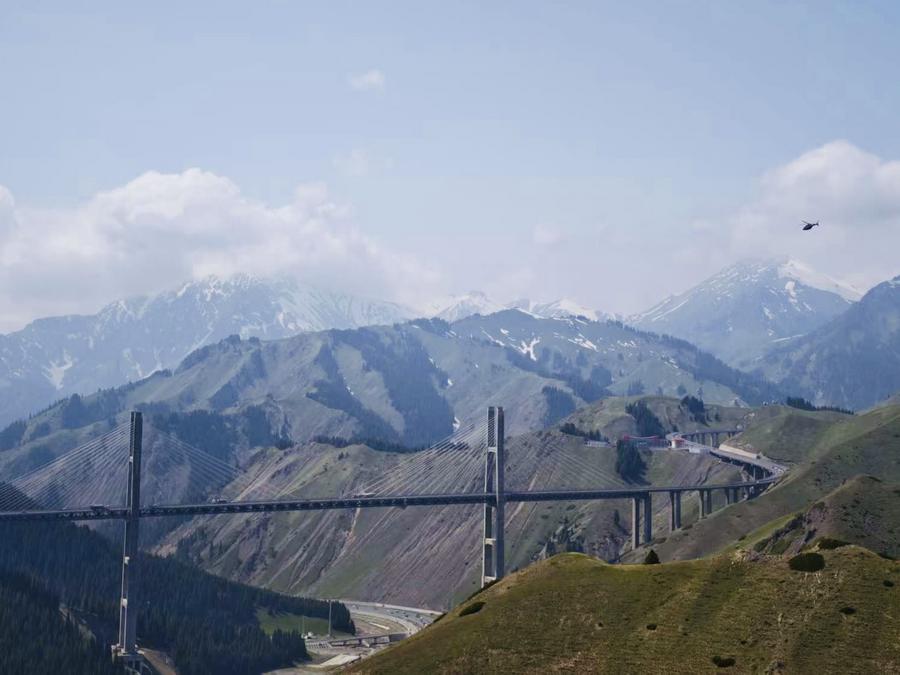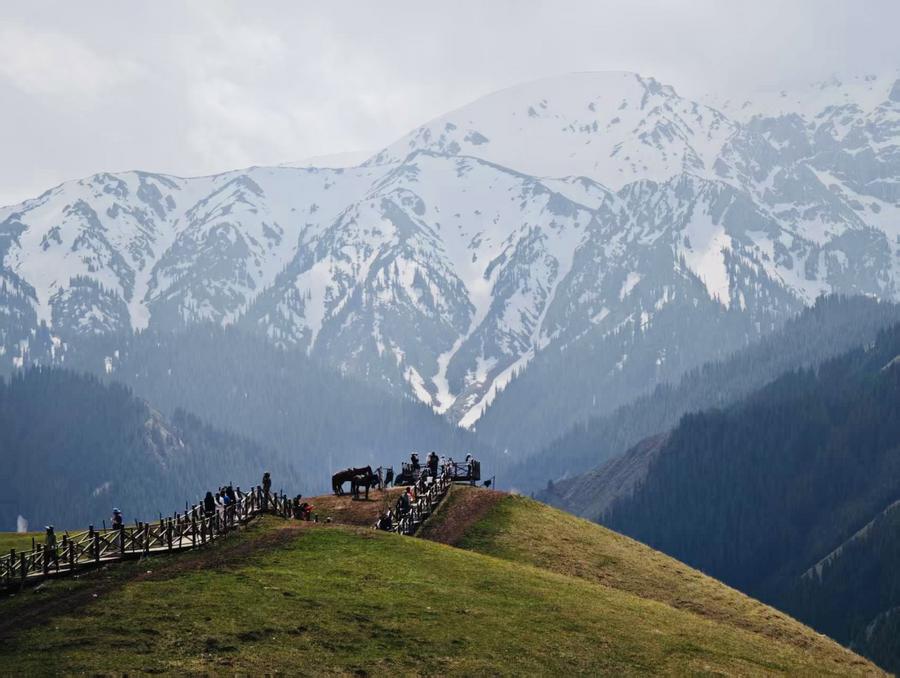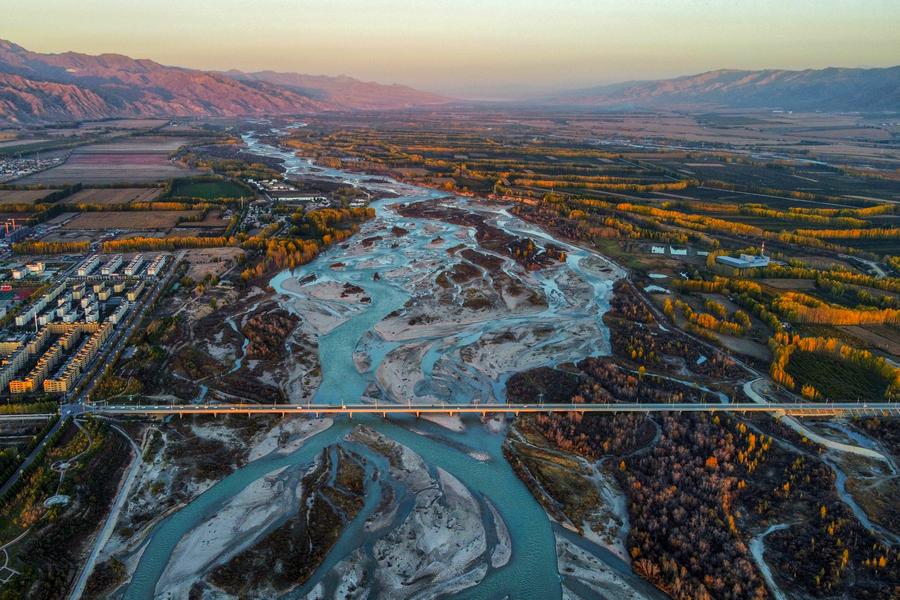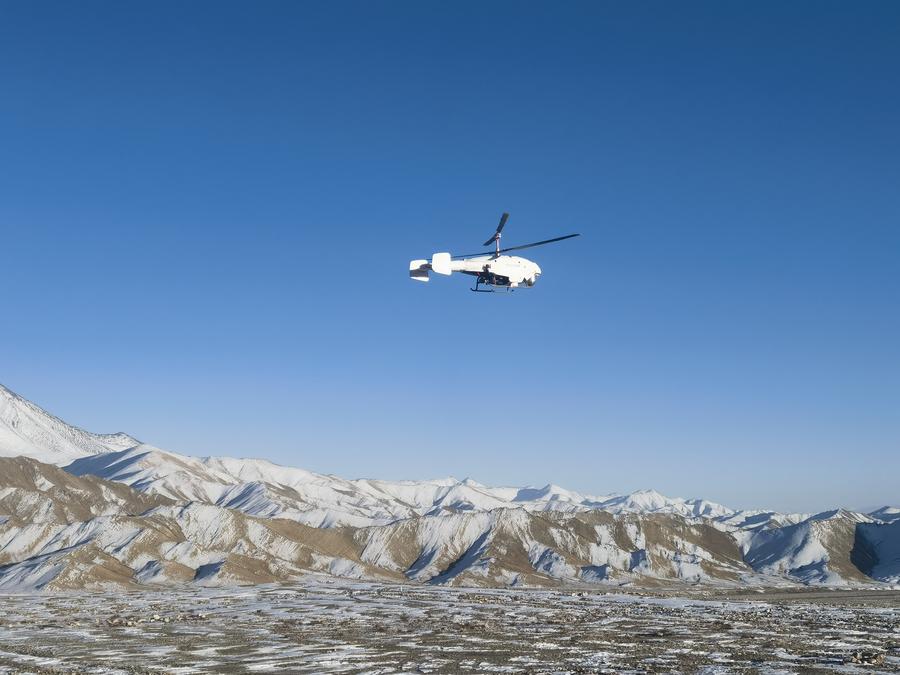


This photo shows a view of Guozigou Bridge in Huocheng County, northwest China's Xinjiang Uygur Autonomous Region, May 1, 2025. (Xinhua/Jia Zhao)
URUMQI, May 18 (Xinhua) -- I felt a gentle tremble as I climbed onto the viewing platform, partly because I was underdressed and partly due to the awe-inspiring view. From the distant snow-capped peaks to the green canyon below, and the majestic Guozigou Bridge in between, the breathtaking mountain scenery stretched as far as the eye could see.
This was one of the most memorable stops on my journey through northwest China's Xinjiang Uygur Autonomous Region in early May. The platform has gained popularity online, thanks to numerous recent posts on "rednote," an app better known as Xiaohongshu, promoting a "must-photograph" site there -- a rugged 2-meter-high cliff that can only accommodate one person atop it at a time, while photographers below use drones to capture images.
With the faraway snowy mountains and towering spruce trees in the background, the drone photos can create an illusion of standing at a great height, giving a thrilling impression of the person "jumping off a cliff."

This photo shows a view of Guozigou scenic spot in Huocheng County, northwest China's Xinjiang Uygur Autonomous Region, May 1, 2025. (Xinhua/Jia Zhao)
There was a long queue of tourists at the foot of the huge rock, each waiting for their chance at a clifftop encounter, while the hum of hovering drones, as well as the screams of timid travelers, was a constant presence.
The high-profile photo spot is not the only example of drone-related tourism in Xinjiang, a region that boasts a flight area of around 1.8 million square km, accounting for one-sixth of the country's total. Enthusiasts can enjoy more than 320 days of good flying weather throughout the year, making it an ideal destination for aerial activities.
Drones have increasingly become a must-have piece of equipment for tourists in Xinjiang. Local tour guides are touting their drone skills to attract more clients; some scenic areas have begun offering shared drone services; and everywhere one looks, young women in long, brightly colored dresses are posing against the green grass and blue lakes, while their amateur pilot partners nervously seek out the perfect shot.

Tourists take a hot air balloon at Jiangjunshan International Ski Resort in Altay, northwest China's Xinjiang Uygur Autonomous Region, Jan. 25, 2025. (Xinhua/Hu Huhu)
In addition to drones, sightseeing tours with helicopters and fixed-wing aircraft have taken off across the region over the past two years. Powered hang gliders and air balloons are growing from niche to sought-after experiences.
Deng Lili is one such thrill-seeking tourist. She took a 25-minute helicopter ride from northern Xinjiang's Shihezi City during the recent May Day holiday, flying over some of the region's iconic landscapes, including the Tianshan Mountains and Manas River Grand Canyon.
"It was gorgeous," she recalled with exhilaration. "Seeing the emerald rivers and winding red rocks from above was a truly fantastic experience."
Since Xinjiang is home to a range of stunning natural and cultural attractions, and these scenic spots are located at considerable distances from one another, it offers an opportunity to develop aerial sightseeing. Ji Deyuan, vice general manager of the company Xinjiang Tongyong Aviation, told me that there is already stiff competition across Xinjiang, as there are 20 low-altitude tourism zones and 15 air tourism companies offering 16 routes.

An aerial photo taken on Oct. 9, 2024 shows a view of the Tekes River in Tekes County, Ili Kazak Autonomous Prefecture, northwest China's Xinjiang Uygur Autonomous Region. (Photo by Zhao Fengshou/Xinhua)
Behind the aerial tourism boom lies Xinjiang's strategic push to lead China's burgeoning low-altitude economy. Since the sector was listed in the country's 2024 government work report as a "new engine of economic growth," Xinjiang, like many places, has incorporated the low-altitude economy into its development plan.
The region aims to build a total of 98 general aviation airports by 2035, equating to around 5.9 airports for every 100,000 square km once completed. Additionally, an industrial park focusing on the research and development, production and maintenance of drones and manned aircraft is currently in the planning and construction phase.
A think tank report on the development of Xinjiang's low-altitude economy estimates that by 2025, China's low-altitude economy is expected to exceed 1.5 trillion yuan (about 210 billion U.S. dollars) in market size, and Xinjiang will become one of the fastest-growing areas in the country.

This file photo taken in October 2022 shows a TD550 coaxial unmanned helicopter in a trial flight on the plateau in Hetian, northwest China's Xinjiang Uygur Autonomous Region. (Xinhua)
For travelers, the trend offers a fresh lens to appreciate nature from above; for entrepreneurs, it is a playground of innovation. Some cutting-edge flying vehicles, such as the "Land Aircraft Carrier," a flying car developed by Chinese EV company Xpeng, have made local headlines by conducting high-temperature and high-altitude tests in Xinjiang.
Local media also reported that a Xinjiang aviation firm was considering the use of EH216-S, an autonomous "flying taxi" featuring vertical takeoff and landing by Chinese drone maker EHang, to launch aerial sightseeing services in popular scenic spots like Nalati and Kalajun grasslands.
Low-altitude tourism has come under the spotlight as the country champions the orderly development of low-altitude sectors to boost consumption. As more companies enter the market, the potential for the sector seems nothing less than sky-high.
by Xinhua writer Yuan Quan
点击右上角![]() 微信好友
微信好友
 朋友圈
朋友圈

请使用浏览器分享功能进行分享
